
Transit Briefs: CTA, NYMTA, TTC, WMATA
Written by Marybeth Luczak, Executive Editor
CTA has launched its latest Innovation Studio program seeking proposals from the private sector to address business challenges through new technology. (CTA Photograph)
Chicago Transit Authority (CTA) seeks innovators to test new technologies that improve rail safety, asset management and real-time information. Also, New York Metropolitan Transportation Authority (MTA) boosts subway security; Toronto Transit Commission (TTC) releases a Request for Proposals (RFP) for the Bloor-Yonge Capacity Improvements project; and Washington Metropolitan Area Transit Authority (WMATA) and Hitachi Rail are offering a “sneak peek” of the new 8000 series rapid transit cars.
CTA
CTA has launched Innovation Studio 2024. Each year, the transit agency seeks proposals from the private sector to address business challenges through new technologies. In 2024, it is looking for test technologies that improve rail safety, specifically “the automatic detection of people or large objects on train tracks to avoid collision, and either reduce or eliminate service delays”; asset management, specifically the automation of the now-manual process of surveying conditions and using physical assets at more than 10,000 bus stops systemwide; and real-time information, specifically the “expansion of real-time arrival and service alert information at bus stops (sheltered and unsheltered) throughout the system.”
“The challenge that CTA and other transit agencies face is that no two system are alike,” said Molly Poppe, Chief Planning and Innovation Officer at CTA. “Each has its own unique set of circumstances that cannot be replicated outside of the actual transit system, which has historically made the testing of solutions cumbersome and costly. This approach to soliciting proposals [through Innovation Studio] allows CTA to be more agile and iterative, which in turn allows us to demonstrate the value of a solution before committing to a full-scale deployment.”
CTA is accepting proposals for innovative pilots or proof of concepts (POC) through April 15, 2024 (11:59 p.m. CT).
An internal CTA review panel comprising representatives from a variety of departments will evaluate the proposals for responsiveness, feasibility and timeline. Once the pilots and POCs are selected, CTA said it will work closely with the vendors to develop and launch pilots and POCs on the transit system for up to one year. The first of the pilots are expected to begin later this year. Based on the successful completion of the various pilots and pilot evaluation, CTA said it will determine next steps, potentially including issuing a formal procurement to deploy the technology on a wider scale.
NY MTA
New York Gov. Kathy Hochul on March 6 announced a five-point plan that uses state resources to boost MTA New York City Transit subway security:
- Additional state personnel to assist NYPD: MTA said 1,000 members of state personnel will assist with the NYPD’s “enhanced baggage checks at heavily trafficked areas.” This includes 250 members from the New York State Police and the MTA Police Department (MTAPD). Additionally, the Governor is directing the National Guard to make the 750 members currently deployed on Joint Task Force Empire Shield available to supplement this effort under the supervision of law enforcement.
- New program bill to ban “assaulters of commuters and transit workers.” Gov. Hochul on March 6 announced a new program bill that will allow judges to ban people convicted of an assault within the system from using MTA services as part of sentencing. “There is currently a provision that allows a transit ban as a term of sentencing for individuals who assault transit workers, and under Gov. Hochul’s plan, this same provision would be extended to include assaults of anyone within the system,” according to MTA.
- Improving coordination between law enforcement and district attorneys. Gov. Hochul is initiating regular meetings among law enforcement, transit personnel and district attorneys “to coordinate information sharing regarding holding dangerous, repeat offenders within the system accountable.” According to MTA, this will “assist district attorneys with their casework and support existing efforts to keep violent offenders off the streets and out of the subways.” The first meeting will take place during the week of March 10. To assist with this process, MTA said it will hire a new Criminal Justice Advocate, who will be responsible for assisting crime victims. Additionally, the MTAPD will develop a new early-warning system to flag recidivist offenders for district attorney offices during booking processes.
- New cameras to protect conductors and staff. “Building on Gov. Hochul’s announcement that MTA is accelerating the installation of cameras inside customer areas of trains, today [March 6] Gov. Hochul is announcing the installation [throughout the system] of new cameras focused on conductor cabins to protect workers,” MTA reported. “These cameras will significantly assist law enforcement personnel as they search for assailants targeting transit workers.”
- $20 Million to expand the SCOUT (Subway Co-Response Outreach) pilot. MTA reported that since January, it has deployed a SCOUT team pilot program across the subway system in partnership with New York City. “SCOUT teams have the capacity to address the most severe cases of mental health crisis within the subway system and assist New Yorkers in gaining access to mental health treatment and supportive housing,” MTA said. “Gov. Hochul is directing $20 million to rapidly scale this pilot and bring the total number of SCOUT teams to 10 by the end of 2025.” The SCOUT teams complement the SOS (Safe Options Support) program teams, which comprise trained mental health professionals who coordinate with New York City-run outreach teams to engage with and assist individuals suffering from chronic street homelessness. The teams connect individuals to critical supportive services and help secure placement in emergency or supportive housing programs.
“Since last year, we’ve installed thousands of new cameras within stations and on-board trains—adding to our already-vast network of 10,000 devices, which have been proven time and time again to lead to police apprehensions and even deter crime,” MTA Chair and CEO Janno Lieber said. “And now, we’re moving forward with cameras in conductor cabs to address the risks our brave conductors and operators are facing. We can’t afford to not act. The transit system is too important to the city and region to allow the perception of safety, or lack of it, to scare people away.”
MTAPD Chief of Operations Thomas Taffe commented: “I know that a focus on reducing the fear of crime is as important as reducing crime itself. We now have officers at commuter hubs in all five boroughs, officers working overnight clearing trains, working with homeless outreach partners across different agencies in all corners of the city. We’re focused on using data to respond to the issues that most affect riders—feelings of disorder, fare evasion, and persons acting violently in emotional distress.”
Brooklyn District Attorney Eric Gonzalez said: “New York’s subways are the beating heart that keeps our city moving, and the safety of riders and MTA employees is a top priority for my office. The comprehensive plan proposed by Gov. Hochul will help us achieve that goal and I thank her for the leadership and ongoing commitment to public safety. We look forward to continuing to collaborate with all of our partners to fight crime on public transportation.”
TTC
TTC on March 5 reported issuing an RFP to three teams for the C$1.5 billion Bloor-Yonge Capacity Improvements project, which is slated to significantly expand and rehabilitate the existing subway station to improve efficiency and capacity and to reduce overcrowding during rush hours.
The three teams, which were shortlisted through a Request for Pre-qualification process conducted last year, are now invited to respond to the RFP. They are:
- Bloor-Yonge Crossline Partners: The team lead is Aecon Infrastructure Management Inc.
- EllisDon-Barnard Joint Venture (a joint venture of EllisDon Civil Ltd. and Barnard Constructors of Canada LP): The team lead is EllisDon Civil Ltd.
- Kenaidan Murphy Joint Venture (a joint venture between Kenaidan Infrastructure Ltd and Murphy Infrastructure Inc.): The team lead is Kenaidan Infrastructure Ltd.
The teams will submit their proposals later this year, and TTC said it expects to award the contract by the end of 2024. Construction is expected to begin in 2026.
The cost of the Bloor-Yonge Station Capacity Improvements project will be funded jointly by the city of Toronto, government of Ontario and government of Canada. Work will include construction of a second platform on Line 2 for eastbound service; expansion of the Line 1 northbound and southbound platforms; new elevators, escalators and stairs; and construction of a new accessible entrance and exit on the south side of Bloor Street East.
“The expansion of Bloor-Yonge station is part of Ontario’s [C]$80 billion investment in public transit—the largest expansion in Canadian history,” said Prabmeet Sarkaria, Minister of Transportation. “Working with the city of Toronto, Premier Ford and our government will continue to invest in public transit to make life more convenient and affordable for families, supporting economic growth for decades to come.”
“I am pleased to see the expansion of Bloor-Yonge Station moving forward, as we work to ensure that public transit infrastructure keeps up with the pace of growth,” Toronto Mayor Olivia Chow said. “I am grateful for the support of all levels of government in this project, as we continue to work towards a reliable, accessible, safe, and modern transit system now and in the future.”
“Bloor-Yonge Station is one of the busiest stations in the TTC’s network, and this project will significantly renovate and expand the station,” TTC Chair Jamaal Myers said. “I look forward to the proposals that will be put forward by the teams, as we work to expand the station to grow ridership and ensure we have reliable public transit for the riders who use it every day.”
WMATA
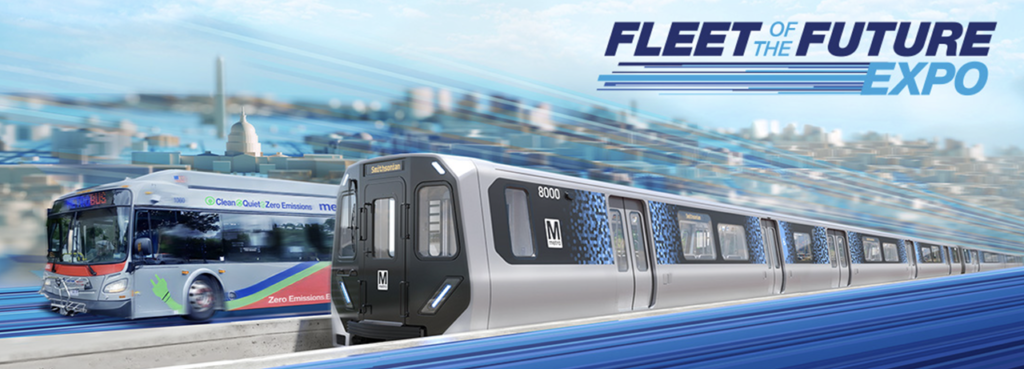
WMATA will display a mock-up of its new 8000 series railcars from Hitachi Rail, plus one of its new 60-foot zero-emissions buses, at the Fleet of the Future Expo, to be held March 20-April 3 on the National Mall (12th Street and Madison Drive NW near the Smithsonian National Museum of American History and National Museum of Natural History).
According to WMATA, the first time it hosted such an exhibit was in 1968. A prototype of the original 1000 series car was built and displayed across the region, including on the National Mall, at regional malls like Prince George’s Plaza and L’Enfant Plaza, and on the White House lawn, where then President Lyndon B. Johnson took a tour (see below).
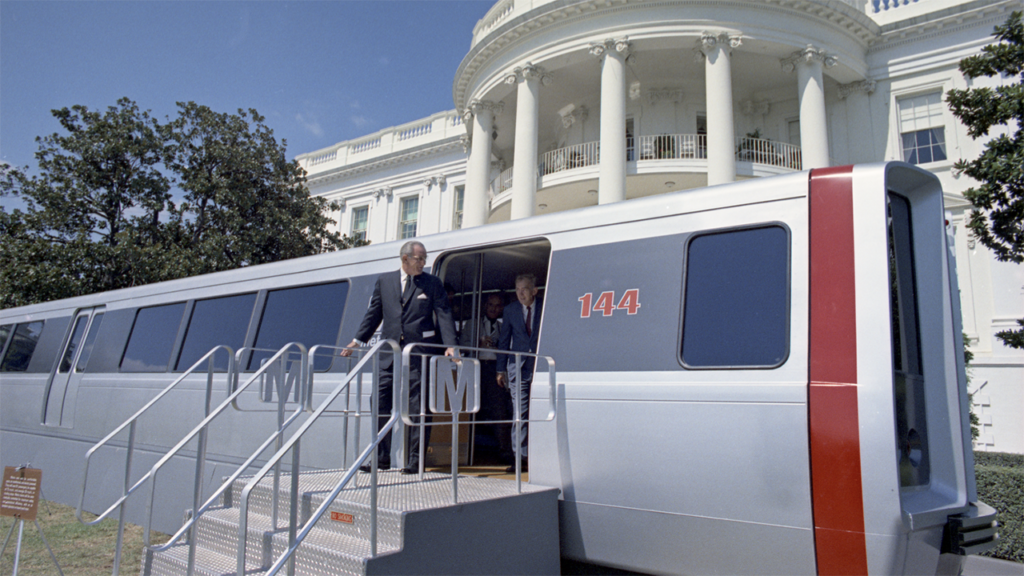
“Unveiling the Fleet of the Future marks a major step,” WMATA General Manager and CEO Randy Clarke said. “We took best practices from all over the world—open gangways, more space, better digital screens for real-time information, enhanced video systems to improve safety, a more sustainable aluminum shell, and eye-catching design—and put them in this train. We are proud of all the improvements we were able to pack into this new fleet and welcome everyone to come out and see the future of America’s transit system.”
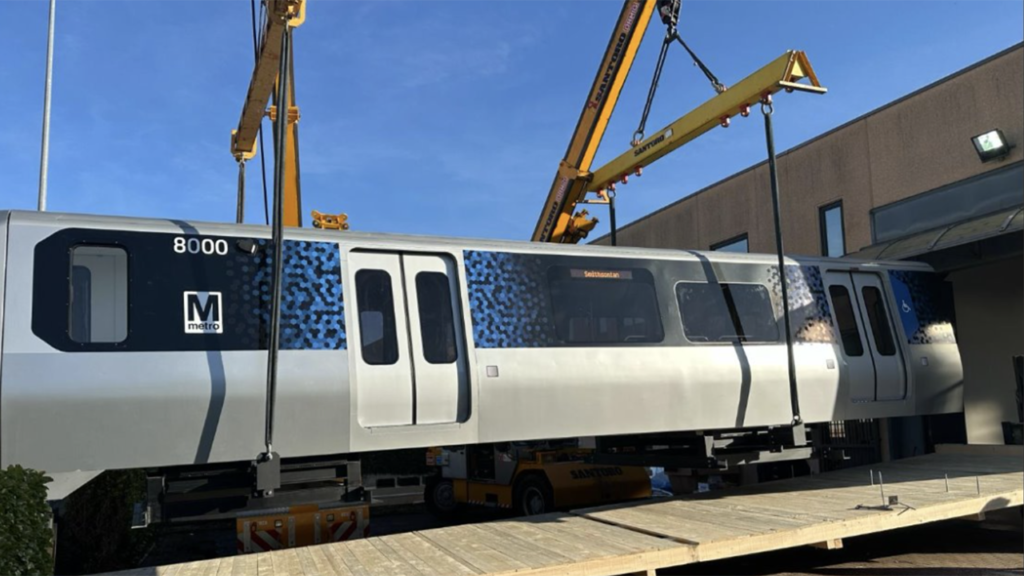
The 82-foot long and 10-foot wide mock-up is not a full-size replica of the two connected open gangway 8000 series cars, but rather features portions of each to give customers an idea of what the trains will feel like, according to WMATA (see above). Unlike the final manufactured product, the prototype will have manual doors, use stickers in some places to represent digital displays, have different lighting, and have molded rather than fabric seats; it will not include heated floors.
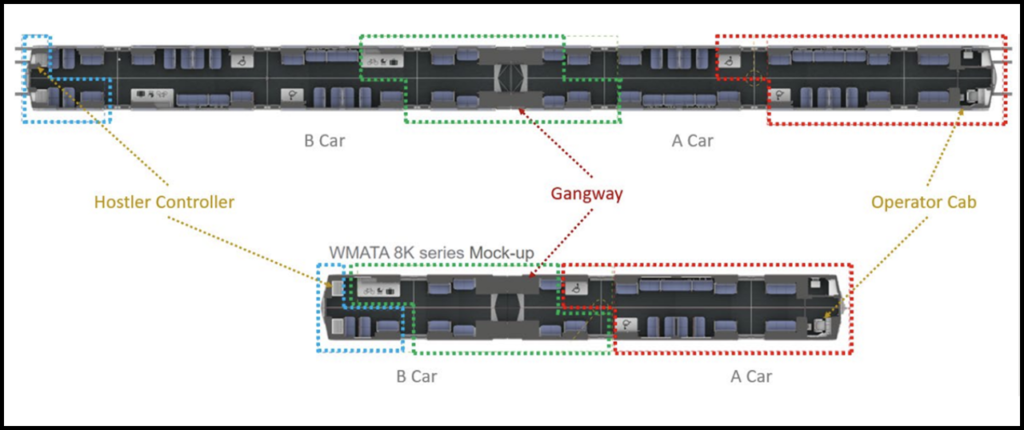
The actual trains will feature WMATA’s first open gangway design that will help increase safety, passenger flow, and capacity, according to the transit agency. Eight-car trains will be made up of four sets of two-car pairs, and six-car trains will be made up of three sets of two-car pairs. The trains will offer more seating along the walls to allow more standing room for passengers and dedicated spaces for people who use mobility devices. Additionally, they will have more flexible space for bikes, strollers, and luggage.
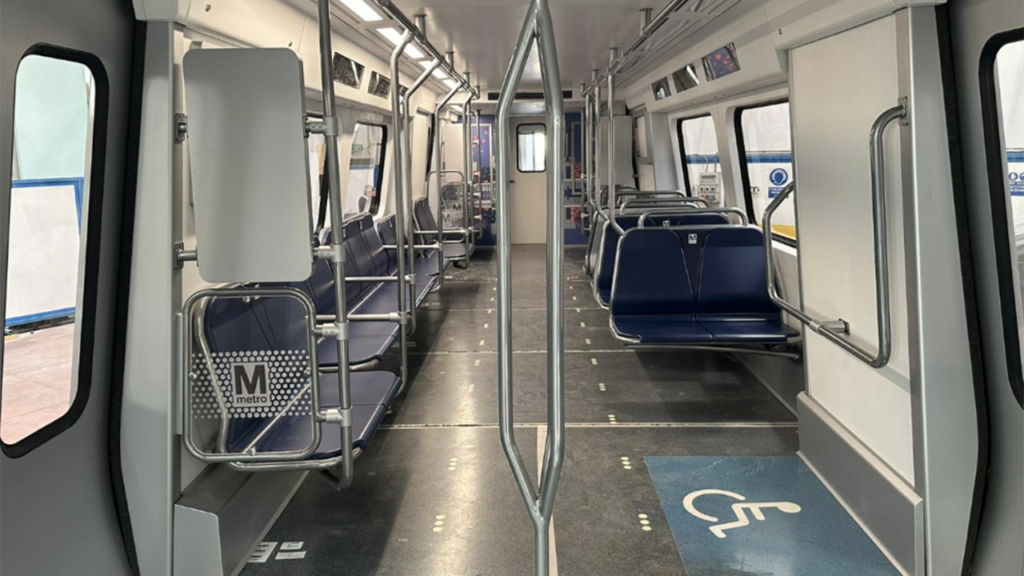
According to Hitachi Rail, the trains will also include digital screens with improved journey information and on-board Wi-Fi; “Smart Doors” with individual response to obstructions; and high-definition security cameras. They will feature ventilation system improvements, incorporate “stringent cybersecurity requirements,” offer increased space between seats and wider aisles, include heated floors throughout, and provide improved regenerative braking.

WMATA in 2021 awarded Hitachi a contract to design and build an initial order of 256 8000-series rapid transit cars, which will replace aging 2000- and 3000-series cars that have been in service since the early 1980s and were manufactured by Italian firm Breda (now Hitachi Rail Italy). If all options in the contract are exercised, a total of 800 cars will be supplied to the agency, worth up to $2.2 billion.
Hitachi Rail will assemble the cars at its new Hagerstown, Md., plant. The factory building, now under construction, will cover 307,000 square feet, including a large production area, warehouse and main office, according to Hitachi Rail. The manufacturing facilities will be built on a 41-acre plot, which will also be equipped with an 800-yard test track allowing dynamic testing of trains on-site. When fully operational in summer 2024, Hitachi Rail’s factory will have the ability to produce 20 railcars per month on a single shift. It will also be capable of building trains of different types, from trams and metros to high-speed trains, Hitachi Rail reported.
“Our Hagerstown digital train factory will act as a flagship for Hitachi Rail’s business in North America,” said Giuseppe Marino, Group CEO at Hitachi Rail. “We believe the new 8000 series railcars will significantly enhance passenger experience for Metro [WMATA] riders and Hitachi Rail is proud to be part of this legacy—continuing our decades long history of transit project delivery in the United States. At Hitachi Rail our mission is to provide more seamless, sustainable journeys for passengers, customers and cities. The creation of this new factory in Maryland reflects our ambition to deliver for the United States.”



